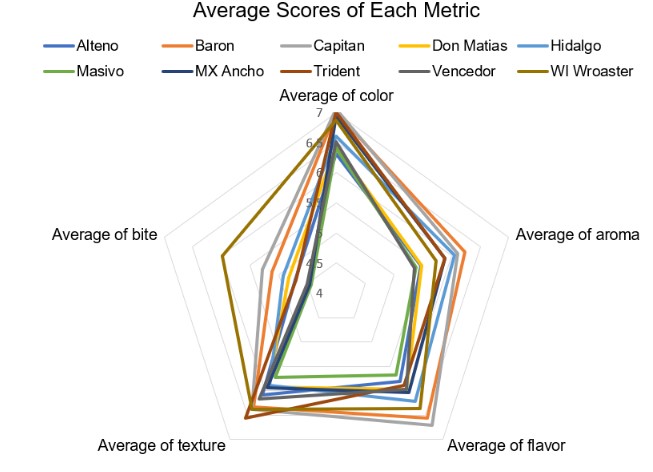By Benjamin Phillips
In 2018, Michigan State University grew eight varieties of poblano peppers and one cross between a poblano and another type of Mexican chile pepper (WI Wroaster). The goal was to evaluate early ripening of these varieties for processing into traditional Mexican dishes. Green poblanos are the unripened fruits that are probably more familiar to consumers as a stuffing pepper when making chile relleno. Similar to cucumbers or zucchini, they are often eaten before the seeds mature. Ripe poblanos are sweeter than bell peppers with a slight spice (compared jalapenos). When they reach this level of ripeness, they make great sauces. In our trial, we tested nine varieties for yield, agronomic characteristics, ease of drying and taste.
Hilda McShane, a collaborating sauce-maker from Genesee County, took a sample of all of the dried poblano varieties that were planted and made an enchilada sauce out of each variety, and also included an imported dried poblano from Mexico (MX Ancho). Then, she incorporated the sauce from each variety into enchiladas in 9-inch by 11-inch baking pans. Students from the Genesee Career Institute culinary program assisted with this. McShane assigned numbers to each variety for blind sensory evaluations conducted on May 29, 2019 in Genesee County among the Genesee Career Institute students and staff, and on June 15, 2019 at the Downtown Saginaw Farmers Market with the general public.

Each participant was asked to score five metrics on a scale of 1 to 9, with 9 being the best. The metrics were color, aroma, flavor, texture and bite. Ideal sauce color is rich reddish-brown. Aroma and flavor should lend an earthy, sweet and slightly spicy effect to the enchilada. Texture should be porridge-like, not too runny or chunky. Bite is a personal preference of heat or spice that lingers in the mouth after eating.
The scores for each metric were then added for a total score. We did not weigh any one category. McShane received 101 completed sensory evaluations and input the data with help from a local high school student. MSU took the sum and mean of the overall scores across all 101 surveys. Rankings were generated by tallying the frequency that a variety was scored higher than another or tied with another. The table below shows this data.
Results
When it came to individual components of the sensory evaluation, the radar graph below shows how each variety averaged for each metric. The somewhat nebulous grading metric of “bite” appeared to have a large effect on the overall scores, with a wide variation. Participants were asked to measure bite as a spiciness level that they enjoyed, which is a polarizing thing to measure.
Wisconsin Wroaster was the highest rated variety for bite, with Capitan and Baron ranked second and third below it. For flavor, Capitan and Baron had the highest average scores, with Wisconsin Wroaster in third. For aroma, Baron had the highest average score, with Capitan in second and Hidalgo in third. For texture, Trident had the highest average score, with Wisconsin Wroaster, Capitan and Baron with scores just below that. Most varieties performed similarly for color, but there is a clear split between Wisconsin Wroaster, Capitan, Baron, Trident and Mexican Ancho and the rest of the varieties.

The varieties with the highest sum and mean scores were Capitan, Wisconsin Wroaster and Baron. For rankings, look for a higher number in the columns for higher rankings. Capitan was rated the best variety or tied for best variety 27 times. Capitan was also rated the second or tied for second best variety 17 times. Wisconsin Wroaster was rated as the third or tied for third best variety 17 times. Baron was close to the top ranked variety in the first, second and third positions, as was the imported dried poblano from Mexico.
What this tells us is that a grown and dried poblano pepper from Michigan is competitive with Mexican imports in regards to culinary aspects. Most of the Michigan grown and dried peppers made a better impression on taste testers in the enchiladas made with their sauces than the standard imported dried poblano, MX Ancho.
Table 1. After taking nine pepper varieties from research farm to the forks of taste testers, the sums, means and rankings were summarized in this table. The standard pepper to compare against was the imported dried poblano, labeled MX Ancho in this trial.
Varieties | Sum total score | Mean total score | Frequency of rankings | Fruit per plant |
|---|
1 | 2 | 3 | 4 | 5 | 6 | 7 | 8 | 9 | 10 | Ripe | Breaker |
|---|
Capitan | 3185 | 31.53 | 27 | 17 | 13 | 3 | 8 | 11 | 5 | 5 | 6 | 6 | 1.38 | 1.14 |
WI Wroaster | 3164 | 31.33 | 17 | 12 | 17 | 10 | 10 | 12 | 8 | 7 | 6 | 2 | 4.00 | 2.57 |
Baron | 3156 | 31.25 | 17 | 12 | 14 | 13 | 14 | 9 | 6 | 11 | 2 | 3 | 1.17 | 2.66 |
Trident | 3034 | 30.03 | 10 | 10 | 12 | 14 | 6 | 15 | 9 | 12 | 8 | 5 | 0.50 | 2.31 |
Hidalgo | 2997 | 29.67 | 16 | 9 | 9 | 12 | 8 | 10 | 10 | 7 | 9 | 11 | 1.33 | 1.04 |
MX Ancho | 2956 | 29.27 | 15 | 10 | 15 | 11 | 5 | 7 | 8 | 9 | 9 | 12 | - | - |
Don Matias | 2892 | 28.63 | 13 | 6 | 6 | 12 | 14 | 9 | 12 | 10 | 9 | 10 | 1.50 | 1.19 |
Vencedor | 2880 | 28.51 | 11 | 14 | 6 | 14 | 4 | 7 | 9 | 16 | 7 | 13 | 1.28 | 1.57 |
Alteno | 2866 | 28.38 | 6 | 9 | 8 | 9 | 12 | 10 | 9 | 14 | 16 | 8 | 1.86 | 1.86 |
Masivo | 2791 | 27.63 | 6 | 8 | 10 | 9 | 8 | 6 | 16 | 9 | 16 | 13 | 0.37 | 0.55 |
Source : msu.edu